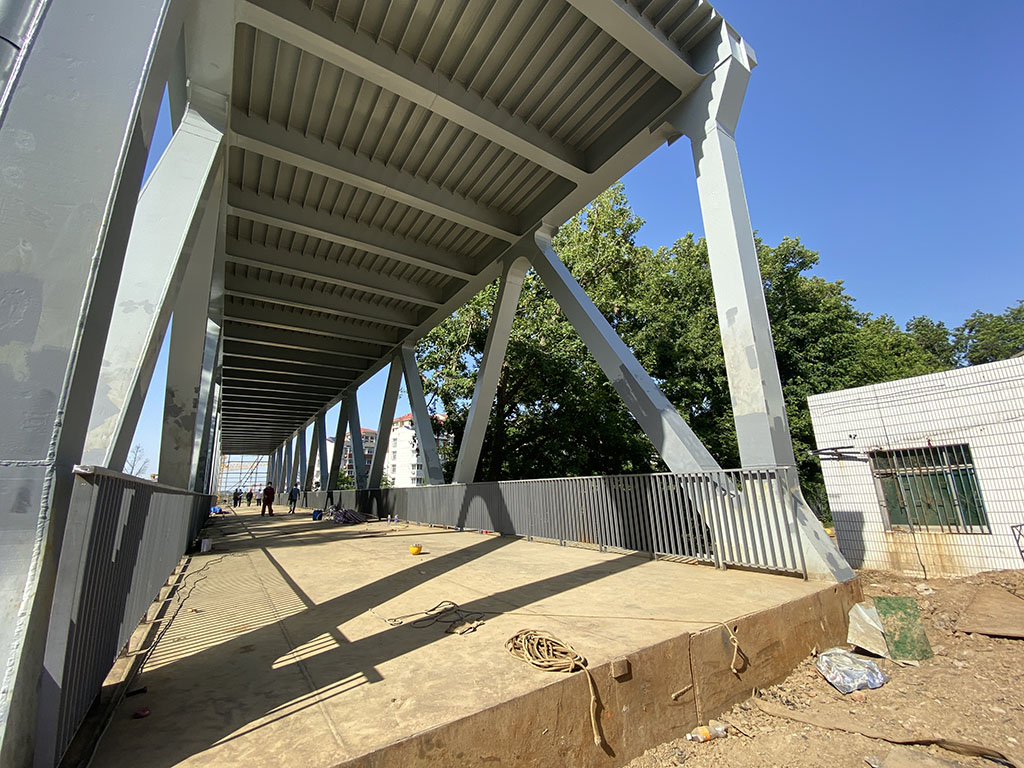A modular steel bridge is a bridge that is quickly assembled from prefabricated standardized steel components. It is efficient, flexible, and reusable, and is widely used in emergency rescue, military engineering, temporary transportation, and construction in remote areas.
Steel bridges have long been integral to global infrastructure, but their designs vary significantly based on functional priorities. Two prominent types—steel truss bridges and modular steel bridges—exemplify how engineering approaches diverge to address distinct needs. While both rely on steel’s strength and truss mechanics, their design philosophies, construction methods, and applications reveal fundamental differences.
1. Design Philosophy and Structural Principles
Steel truss bridges are rooted in traditional civil engineering, emphasizing structural optimization for permanence. They employ triangular truss configurations (e.g., Pratt, Warren, or Howe trusses) to distribute loads efficiently across spans. These bridges are custom-designed for specific sites, balancing factors like span length, load capacity, and environmental conditions. Their geometries are often complex, requiring precise calculations to minimize material use while ensuring durability.
Modular steel bridges, conversely, prioritize adaptability and speed. They consist of prefabricated, standardized components (panels, beams, connectors) that can be rapidly assembled like “building blocks.” While some modular designs incorporate truss elements (e.g., Bailey Bridges), these trusses are simplified and standardized to enable quick deployment. The focus shifts from site-specific customization to universal compatibility, allowing modules to be reused across projects.
Connection: Both leverage steel’s high strength-to-weight ratio and truss principles for load distribution. However, truss bridges prioritize bespoke efficiency, while modular systems sacrifice customization for versatility.
2. Construction Methods and Timelines
Steel truss bridges demand intensive on-site labor. Components are typically fabricated off-site but require welding, bolting, or riveting during assembly. Heavy machinery like cranes is essential, and construction can span months or years, particularly for long-span or architecturally intricate projects.
Modular steel bridges revolutionize construction logistics. Components are mass-produced in factories, pre-treated for corrosion resistance, and shipped to sites. Assembly involves bolting or pinning modules together, often without specialized equipment. This method reduces on-site work from months to days—critical in emergencies like disaster relief or military operations.
Difference: Modular bridges eliminate most on-site fabrication, drastically cutting time and labor costs.
3. Applications and Longevity
Steel truss bridges dominate permanent infrastructure. They support highways, railways, and iconic structures (e.g., the Sydney Harbour Bridge) with spans exceeding 100 meters. Their robust design accommodates heavy static loads, such as dense traffic or rail networks, and they often serve for decades with minimal retrofitting.
Modular steel bridges excel in temporary or semi-permanent scenarios. They are deployed for disaster recovery (e.g., post-earthquake road restoration), military logistics (e.g., Bailey Bridges in WWII), or rural access where traditional construction is impractical. Their typical spans range below 60 meters, though modular units can be combined for longer spans with intermediate supports.
Connection: Both address transportation gaps but cater to opposing timelines—permanence versus agility.
4. Cost Efficiency and Maintenance
Steel truss bridges incur high initial costs due to custom engineering, material quantities, and prolonged construction. However, their longevity (50–100 years) amortizes costs over time. Maintenance focuses on corrosion prevention (e.g., painting, galvanizing) and periodic inspections.
Modular systems offer lower upfront costs for short-term use. Savings arise from standardized production and reusability—modules can be disassembled and redeployed. However, frequent assembly-disassembly cycles may increase wear on connectors, necessitating part replacements.
Difference: Modular bridges are cost-effective for transient needs, while truss bridges prove economical over decades.
5. Sustainability and Innovation
Modular steel bridges hold an edge in sustainability. Reusable components reduce waste, and rapid installation minimizes ecosystem disruption. Innovations like high-strength steels and composite materials further enhance their efficiency.
Steel truss bridges, though durable, generate higher carbon footprints during prolonged construction. However, advancements in corrosion-resistant alloys (e.g., weathering steel) and digital design tools (e.g., BIM) are improving their environmental performance.
Case Studies
- Bailey Bridge (Modular): A WWII innovation, this truss-based modular system remains a military and disaster-relief staple due to its rapid assembly and adaptability.
- Ikitsuki Bridge (Truss): Japan’s 400-meter continuous truss bridge exemplifies the endurance and load capacity of traditional designs.
Steel truss and modular steel bridges represent two sides of infrastructure engineering: one optimized for permanence, the other for adaptability. Their shared reliance on steel and truss mechanics underscores engineering continuity, yet their divergent priorities define their roles. As technology advances, hybrid systems are emerging—modular bridges with longer spans, or truss designs incorporating prefabricated elements—blurring the lines between these categories. Ultimately, both remain vital to addressing the evolving demands of global connectivity.
Post time: Apr-23-2025


